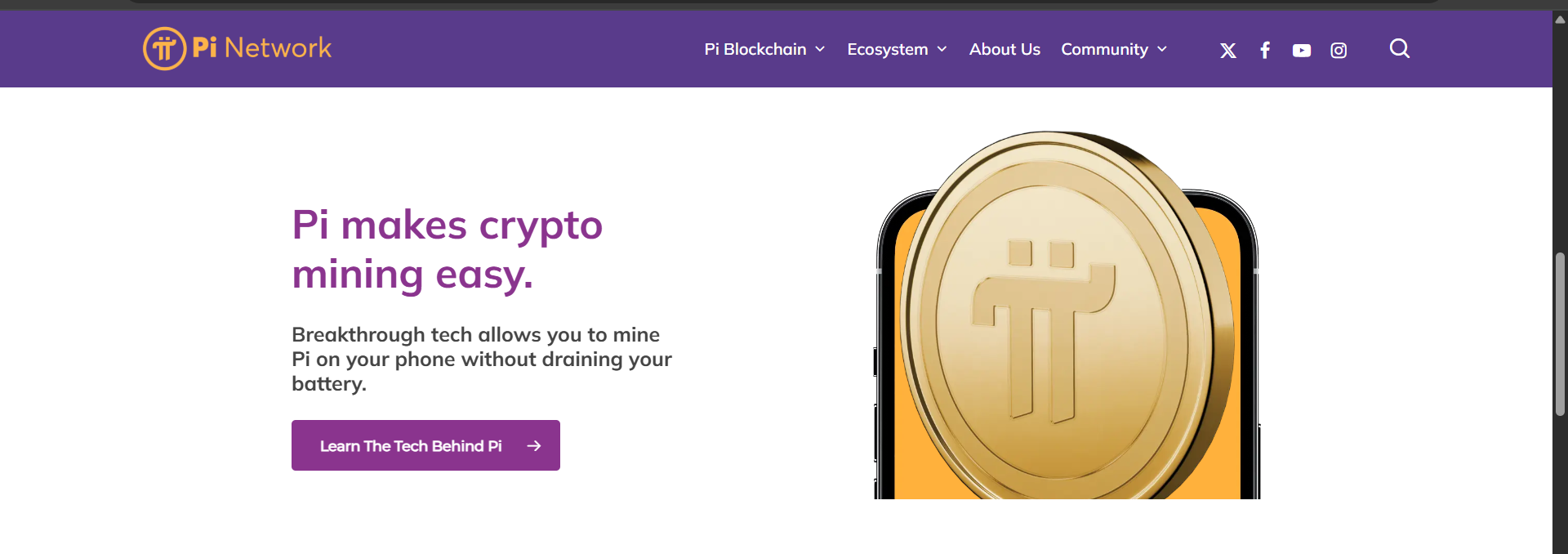Table of Contents
ToggleThe Hype vs Reality of Pi Coin.
When the Pi Network officially launched its open mainnet in February 2025, excitement surged across crypto communities . With over 60 million users and a promise of mobile-first , low-energy mining , Pi Coin seemed ready to challenge traditional cryptocurrencies .
At launch , Pi Coin hit a high of $2.99 , fueled by community enthusiasm and speculative trading . But now, just five months later, it’s trading around $0.48- an over 80% decline
This image shows the Pi Coin (PI/USDT) daily trading chart from TradingView , captured in July 2025. It highlights the price drop after the open mainnet launch earlier this year .
Quick Recap: What Is Pi Coin?
If you’re new to the Pi ecosystem, you can check our full guide:
What Is Pi Coin and Is It Worth Anything in 2025? Legit Or Scam
Pi Coin is the native currency of the Pi Network, built to make crypto accessible via mobile mining. Users simply tap their phone once every 24 hours to mine tokens, no energy-heavy computing needed .
Price Volatility After Launch
Like most new cryptocurrencies, Pi Coin experienced a speculative surge at launch .Within days of the launch, Pi Coin surged to $2.99, driven largely by hype, community enthusiasm, and speculative trading.
But the excitement didn’t last long . Within weeks, Pi’s price dropped sharply , falling below $1 by March and hovering around $0.48 by July 2025 . That’s an 80% drop from its launch high . Currently, the price is fluctuating , with recent values around $0.465 to $0.5025 . Many users had been mining Pi for years , and the open mainnet allowed them to finally trade or cash out .
As supply flooded the exchanges , early profit-takers sold their tokens, driving the price down rapidly .
How Locked Pi Tokens Affect the Price and Market Supply ?
One of the most overlooked reasons behind Pi Coin’s volatile price after launch is the huge imbalance between the total mined tokens and the relatively small number of coins actually available for trading on the open market .
While millions of users have mined Pi over the past few years , a large portion of those tokens are still locked ( meaning they cannot be traded, withdrawn, or used until users complete KYC (Know Your Customer) verification and wallet migration ). This delay has created a situation where the circulating supply is extremely limited , even though the total supply appears massive .
This lockup system is part of Pi Network’s strategy to gradually decentralize the token and prevent a massive sell-off . But it also creates a side effect : high price sensitivity . When Pi’s mainnet launched and a limited amount of tokens entered exchanges , many users rushed to sell . But with low liquidity, the price couldn’t handle the selling pressure , and it dropped fast .
Until more users pass KYC and unlock their tokens , the market will remain unstable and unrepresentative of true demand or value .
KYC and Wallet Issues ?
To move your mined Pi coins to the mainnet (where they become real and usable),user must complete KYC . Millions of users are still waiting for their KYC invitation . Some get stuck because of technical errors , blurry photos , unsupported documents , or slow approval times . Users from certain countries also face problems due to lack of local ID support . Without KYC, you can’t unlock your Pi coins , so they remain in your app but are useless .
Wallet Issue:
Even for users who completed KYC , many are struggling to set up and use their Pi wallets . The wallet is where your real Pi coins are stored after transfer. But some users face errors during wallet creation or linking it with their account . Others accidentally lose access by forgetting their passphrase( a 24-word security key needed to recover the wallet ). Since there’s no customer support or reset option , once lost , those coins are gone forever.
Why Pi Isn’t Listed on Major Exchanges Yet ?
Another reason behind Pi Coin’s price struggles is the limited number of exchanges where it is listed . Most top crypto exchanges like Binance , Coinbase , or Kraken still don’t support trading of Pi officially .
This is because Pi Network has not fully met the listing requirements , which usually include full decentralization , transparent tokenomics , strong liquidity , and security audits . As a result , Pi is currently traded on smaller or less-known platforms , often through IOUs (promises to deliver actual Pi later) , which adds confusion and risks for traders .
Without major exchange listings , it’s hard for new investors to trust or access the coin . It also affects trading volume and visibility.
Trust Issues and Scams .
As the price dropped and delays increased , many Pi users began expressing doubts about the project . Some called it a scam , while others felt misled after years of mining with high hopes . Social media platforms and forums are filled with mixed reactions – some users defending Pi’s long-term vision , others demanding faster progress and more transparency .
Fake Pi wallets and scam tokens started appearing on unofficial exchanges. Some users lost their money by sending Pi to fake addresses or downloading malware wallets . The lack of official guidance and customer support only made things worse.
Concerns About Pi Token Ownership: Who Really Holds Most of the Coins ?
Another growing concern among the Pi community is the uneven distribution of Pi coins , especially how many are believed to be held by the Pi Core Team , early insiders , or centralized accounts .
Several unofficial reports and blockchain snapshots suggest that a large percentage of Pi is controlled by the team and associated wallets .
According to Pi Network’s whitepaper and community estimates , the total maximum supply of Pi is 100 billion tokens , out of which:
-
20% is reserved for the Pi Core Team .
-
10% goes to community development and ecosystem growth .
-
The remaining 70% was intended for mining rewards to be distributed to users over time .
However, due to locked tokens , slow KYC , and manual migration , the tokens that are actually in circulation are very small compared to what’s been mined . This creates a situation where a few wallets , mostly owned by the team or early testnet validators , appear to control a majority of the unlocked supply.
Some crypto analysts tracking open wallet addresses on the Pi blockchain have observed that a handful of addresses hold millions of Pi , while the average user has only a few hundred or thousand . This imbalance has led to accusations of centralization,
Until the team publishes a fully audited and transparent token allocation report , questions about Pi’s fairness and decentralization will remain .
Conclusion –
Pi Coin had a lot of excitement in the beginning , but its price dropped more than 80% after launch . Many users are upset because they can’t complete KYC or use their wallets . Also , most of the Pi coins are still locked or held by the team, which makes the market unstable. Without listing on big exchanges and more transparency, people are starting to lose trust . Pi still has potential , but the team must fix these issues fast . For now , users should be careful , stay informed , and not expect quick profits from Pi Coin . The future is still uncertain .

